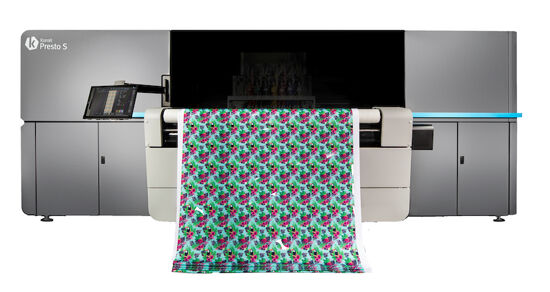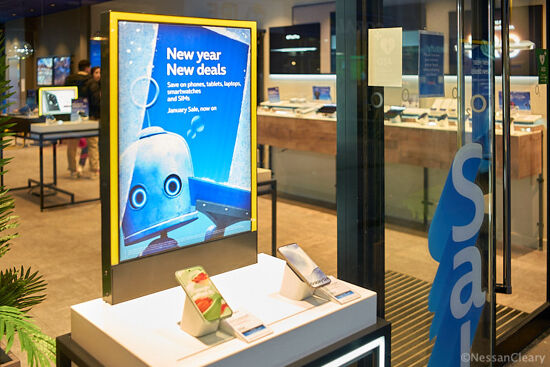The latest innovations for digitally printed Sportswear production
.jpg?width=750)
The latest technologies for sportswear manufacturing continue to drive innovation and disrupt traditional process in this expanding sector. The industry has undergone a transformative journey in 2023, with advancements in printing machinery, software, process and materials playing a pivotal role.
As a sector - The global sports clothing market is estimated to register a CAGR of 4.20% during the forecast period. The global market is likely to capture a valuation of US$ 3,15,035.4 million in 2024 and reach US$ 4,75,689.7 million by 2034 (Future Market Insights).
Sportswear is commonly made from a variety of materials and blends, the most popular includes polyester, nylon, and spandex. These synthetic fibers are lightweight, durable, and moisture-wicking; ideal for activewear. New developments in material science are importantly driving a systemic change by replacing synthetic fibers with high-performance recycled and natural fibers and blends.
This tech review delves into just some of the latest innovations that are reshaping the landscape of sportswear manufacture and customisation, with a keen focus on print technology, fabrics & process.
DTG (Direct to Garment) Printing Technologies
During the year DTG (direct to garment) printing has been concentrated on overcoming the perennial problem of printing onto sportwear’s most popular fibres - polyester and elastane. Where previously print quality and fastness properties were poor, 2023 saw elegant solutions offered to the industry from a variety of players.
At Kornit Digital, who state that their “MAX Poly technology’s solution is ideally suited to create endless new opportunities for on-demand polyester sportwear customisation. The Atlas MAX Poly achieves exceptional quality in polyester printing for both light and dark polyester. Both dye migration and post-dryer cracking are mitigated, and the fabric retains a soft feeling even with heavy prints. The technology now brings new capabilities for printing direct-to-polyester with vibrant unmatched colours, even neon, in the most sustainable way possible.”
.jpg) Caption: “During the year DTG (direct to garment) printing has been concentrated on overcoming the perennial problem of printing onto sportwear’s most popular fibres - polyester and elastane”. Credit: None
Caption: “During the year DTG (direct to garment) printing has been concentrated on overcoming the perennial problem of printing onto sportwear’s most popular fibres - polyester and elastane”. Credit: None
At the forefront of innovation Ricoh state that the new “Ri 4000 with the newly developed Enhancer (pretreatment) liquid and Ink realises customers' business growth goals by printing on 100% Polyester material and high-polyester blends with ease. With the built-in enhancer technology, the RICOH Ri 4000 eliminates the inconsistent quality of manual pretreatment to achieve the highest work efficiency”. Their latest technologies offer customised production and deliver industrial garment printing at an affordable price for enterprise users who have demands for sportswear printing on polyester.
DTF (Direct to Film) Technologies
Direct-to-film printing is suitable for heavy-duty sportswear, outerwear, and apparel accessories.
Recently launched for 2023 is the Brother GTX Pro Series DTF Printer who state that “With its advanced technology and user-friendly interface, this printer offers exceptional print quality and fast production speeds. The Brother GTX Pro Series is designed to handle high-volume printing while ensuring accurate colour reproduction and durability. The printer features a large print area, allowing for maximum design possibilities. It also utilizes Brother’s proprietary ink technology, which ensures vibrant colours, excellent washability, and long-lasting prints. The Brother GTX Pro Series DTF Printer is suitable for both small businesses and large-scale production environments.”
From M&R The QUATRO™ Direct to Film (DTF) Transfer Printing System is their newest printing solution, offering high-quality prints with high-quality value. M&R state “The printed apparel decorating industry continues to evolve at a rapid pace, due to several notable trends and technology advancements that are shaping the industry. The M&R QUATRO (DTF) Transfer Printing System is a modern and efficient method of applying vibrant, high-quality durable images onto a wide variety of garments and fabric types”.
“The DTF process begins with the creation of a digital design on a computer. Once the design is finalized, it is printed onto a special PET film with a specialized digital inkjet printer using Cyan, Magenta, Yellow, Black and White pigmented aqueous inkjet inks. After printing is complete, and while the ink is still wet, the transfer is prepared by applying a layer of adhesive to the print area. Immediately after the adhesive has been applied, the final construction of film, ink, and adhesive is prepared for the transfer process by running it through a high efficiency infra-red drying system to cure the ink, and to fuse the adhesive to achieve a strong bond between the ink and the fabric, ensuring a durable and long-lasting print.”
Dye Sublimation Technologies
Mimaki dye sublimation printers, together with EarlyVision garment design and visualisation software at Nopinz, are making speed suits for some of the world’s top cycling teams, as well as for competitive amateurs.
The two flagship dye sublimation printers from Mimaki, both the TS300P-1800 and TS55-1800 are equipped to print on the various technical fabrics that are needed for cycling attire and can reproduce colours to meet customer expectations.
EarlyVision’s offering used by Nopinz claims to ‘enable efficient workflows for mass customisation and on-demand manufacturing’. Its systems streamline the design-to-production workflow, allowing designers to focus on design and create nesting-ready files that are prepared for production automatically based on e-commerce orders.
New machinery and ink developments from Epson, state that “the SC-F9400 has been built with efficiency in mind, maintaining a high output, even when printing intense colours for sportswear, and with higher capacity ink pouches, the SC-F9400 will keep running for longer. The SC-F9400 has a maximum print speed of 108.6m2/h for fast turnarounds. The updated settings deliver a lower tension and accurate registration, which improves take-up and reduces the total cost of ownership (TCO) by using lower-weight sublimation papers.”
Developments for dye sublimation transfer paper continue to address industry challenges and to enhance performance, efficiency, and sustainability. At Coldenhove whos Jetcol® has long been regarded as the benchmark for the digital dye sublimation industry. Their Jetcol® product offers a coated sublimation paper with an extremely high transfer yield.
Coldenhove state that the substrate offers up to 97% ideal for sportswear adding “With just 66 gsm, Jetcol® HTR1000 is the lightest paper grade in the Jetcol® Original family. This paper is designed for the faster plotters, with water based sublimation inks most often used by the sportswear industry”. Coldenhove’s Jetcol® HTR1000 paper can handle an ink coverage of up to 240% and offers a range of unique properties such as the possibility to print a wide and bright colour range, fine detail printing and, most importantly, consistent quality.
“It’s this quality that allows you to achieve the same results with every print job, bringing more predictability into your production”. Coldenhove invented digital dye sublimation printing paper in Holland, and their Jetcol® paper was granted a patent in 1998.”
Fabrics For Sportwear Printing
Material science continues to push the boundaries of textile innovation, as the industry gradually moves towards a circular economy, new materials are required to complete the recycling-circular paradigm.
An example of which is the latest innovation Microft AR from the fibre developer Teijin Frontier, who recently launched a new collection of seamless knitwear for outdoor sports, giving it the name Microft AR. It describes the collection as “offering warmth and comfort combined, with a high functionality”. It will launch Microft AR in time for the autumn-winter 2024-2025 season and has predicted that it will sell 100,000 pieces during its 2026 fiscal year.
_1.jpg) Caption: “Material science continues to push the boundaries of textile innovation, as the industry gradually moves towards a circular economy, new materials are required to complete the recycling-circular paradigm”. Credit: None
Caption: “Material science continues to push the boundaries of textile innovation, as the industry gradually moves towards a circular economy, new materials are required to complete the recycling-circular paradigm”. Credit: None
“The clothing is made from 100% recycled polyester, using proprietary Deltapeak high-performance polyester filament yarn as the core. Teijin has said this creates a high-density loop structure to provide favourable raising and bulky heat-insulating performance, while preventing fibres from falling off. Performance properties include sweat-absorbency, quick-drying and high breathability. The garments will also be highly compactable, folding to a small size.”
And from Lycra came COOLMAX® EcoMade PRO technology who state “This specialty polyester fibre is made with 100% recycled resources and combines moisture-wicking, quick dry times and exceptional breathability to deliver next level comfort to all high-impact end uses. COOLMAX® EcoMade technology provides the same reliable cooling performance you expect from the COOLMAX® brand, but it’s made with 100% recycled resources to help the environment. Eco-conscious consumers will also appreciate that this polyester fibre can be made with either 100% textile waste or recycled PET bottles. Either option offers permanent moisture-wicking performance.”
Software For Sportswear Print Production
As the march towards personalised products and customised production accelerates to meet consumer preferences, the use of automation software, and new developments for digital design software are becoming focussed and highly nuanced to remove the challenges of on-demand manufacturing.
At Clo3D, whose developers have the promotional slogan “design smarter” state that using their software “sportswear can be created in a virtual 3D format by attaching the designs to a prescribed avatar. This is done by making virtual patterns from 2D designs, digitally stitching them and placing them onto the avatar. Then, the software works its magic, creating an extremely accurate and vivid virtual garment that can be viewed on-screen turning 360 degrees. Clo3D’s robust simulation engine allows the designer to create countless layers and intricate details prior to printing.”
Another specialist software company in this sector are Browzwear, who state “Our partnership with Freudenberg, allows active printed sportswear to be created with access to more than 30 of Freudenberg’s most popular woven, weft, and nonwoven interlinings for a wide range of applications. Three digital libraries for Active Sportswear, Fashion and Shirts offer designers a quick and easy way to find the right solution to add structure, support, and stability to a garment and see exactly how the look, drape and fit of their virtual creations are accurately presented in true-to-life 3D.”
In a global sportswear market that is projected to grow from $193.89 billion in 2023 to $305.67 billion by 2030 (Research & Markets), and to reach US$ 4,75,689.7 million by 2034 (Future Market Insights). Sports apparel decoration has an embedded share of the sector, and with the many technological advances, the future is indeed a bright prospect for all concerned.
Across the sector customisation and personalisation are driving systemic innovation and digitisation within the sportswear industry.
Discover the latest innovations in sportswear at Sportswear Pro 2024, taking place from 19th – 22nd March 2024. Sportswear Pro will showcase the very latest technologies and solutions for on-demand and customised sportswear production. From sample design and automated digital workflows, to innovative materials and integrated wearable technologies, the exhibition and visionary trend forum will present sustainable, faster and leaner production solutions to sports and activewear brands and manufacturers. Register here and use promo code SWPJ401 and save 55 euros.
Topics
Interested in joining our community?
Enquire today about joining your local FESPA Association or FESPA Direct
Recent news

What is digital textile printing and what are the opportunities?
Nessan Cleary shares how textile printing covers a wide range of different market sectors which vary in opportunities. Nessan discusses sportswear, direct to garment and home décor.

Vote now for the FESPA Awards’ People’s Choice Award!
The voting for the prestigious People's Choice FESPA Award is now open until 7th February where those in the industry have the opportunity to vote for their favourite entries, celebrating the exceptional talent in the industry.
.png?width=550)
FESPA MIddle East 2025 - Day 3 Highlights
The third day of FESPA Middle East, 22 January 2025, featured hundreds of professionals visiting the show to see the latest solutions and innovations in speciality print and signage.

The rise of digital screens
Nessan Cleary discusses the increasing use of digital screen in retail shops which have both pros and cons. They can be cost-effective with a variety of different technologies and resolutions that can be used and reduces the amount of short term printing required. However, they do require high amounts of energy to run. Nessan goes into further detail of the pros and cons in this article.